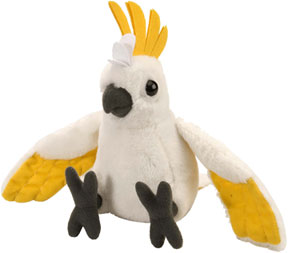

Find out all the information about the Cockatoo at the Forest Cottage.
Cockatoos
(Cacatua) come from Australia and the East Indies. The upper jaw of the bill overlaps the narrow lower jaw. The crest is erectile. The 18-inch White-crested Cockatoo, Cacatua alba, is all white, with a crest of feathers broadened at the tip. It lives in northern and central Moluccas. The Salmon-crested or Pink-crested Cockatoo, Cacatua moluccensis, found in the southern Moluccas, is 20 in. long, with white, salmon-tinged feathers. The longest feathers of its broad crest are red.
Leadbeater's Cockatoo (Cacatua leadbeateri) also of Australia, has a crest that is a combination of red, white and yellow. The upper parts are white, the underparts pink. The Little Corella or Bare-eyed Cockatoo (Cacatua sanguinea) has a small, wide crest and a bare eye-ring. These species are considered pests in Australia because of the damage they do to crops.
The Lesser Sulphur-crested Cockatoo, Cacatua galerita, is almost all white except for the narrow yellow crest and yellow cheeks. Its small size (18 in.) makes it a popular cage-bird. The Galah or Roseate Cockatoo, Cacatua roseicapilla, is light grey above. The head and chest are pink. It is found in western and northern Australia.
The bare cheeks of the giant black cockatoo (Calyptorhynchus magnificus) turn red when it is excited. It lives in the rain forests of New Guinea where it feeds on candlenuts.
The cockatoo builds its nest in a high tree hole in the tropical forest. The female lays two white eggs on wood chips. The young, which hatch naked and blind are fed by the adults by regurgitation of partially digested food for about three months. Cockatoos often travel in immense flocks numbering many thousands. They make good pets and are found in all zoos.
Class: Aves | Order: Psittaciformes | Superfamily: Cacatuoidae | Family: Cacatuidae




